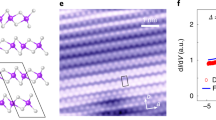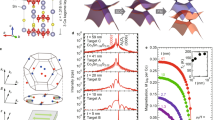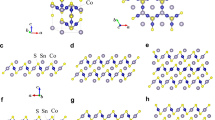Abstract
The investigation of two-dimensional atomically thin superconductors—especially those hosting topological states—attracts growing interest in condensed-matter physics. Here we report the observation of spin–orbit–parity coupled superconducting state in centrosymmetric atomically thin 2M-WS2, a material that has been predicted to exhibit topological band inversions. Our magnetotransport measurements show that the in-plane upper critical field not only exceeds the Pauli paramagnetic limit but also exhibits a strongly anisotropic two-fold symmetry in response to the in-plane magnetic field direction. Furthermore, tunnelling spectroscopy measurements conducted under high in-plane magnetic fields reveal that the superconducting gap possesses an anisotropic magnetic response along different in-plane magnetic field directions, and it persists much above the Pauli limit. Self-consistent mean-field calculations show that this unusual behaviour originates from the strong spin–orbit–parity coupling arising from the topological band inversion in 2M-WS2, which effectively pins the spin of states near the topological band crossing and gives rise to an anisotropic renormalization of the effect of external Zeeman fields. Our results identify the unconventional superconductivity in atomically thin 2M-WS2, which serves as a promising platform for exploring the interplay between superconductivity, topology and strong spin–orbit–parity coupling.
This is a preview of subscription content, access via your institution
Access options
Access Nature and 54 other Nature Portfolio journals
Get Nature+, our best-value online-access subscription
$29.99 / 30 days
cancel any time
Subscribe to this journal
Receive 12 print issues and online access
$209.00 per year
only $17.42 per issue
Buy this article
- Purchase on Springer Link
- Instant access to full article PDF
Prices may be subject to local taxes which are calculated during checkout




Similar content being viewed by others
Data availability
The data that support the plots within this paper and other findings of this study are available from the corresponding authors upon reasonable request. Source data are provided with this paper.
References
Lai, Z. et al. Metastable 1T′-phase group VIB transition metal dichalcogenide crystals. Nat. Mater. 20, 1113–1120 (2021).
Saito, Y., Nojima, T. & Iwasa, Y. Highly crystalline 2D superconductors. Nat. Rev. Mater. 2, 16094 (2017).
Saito, Y., Kasahara, Y., Ye, J., Iwasa, Y. & Nojima, T. Metallic ground state in an ion-gated two-dimensional superconductor. Science 350, 409–413 (2015).
Yang, C. et al. Intermediate bosonic metallic state in the superconductor–insulator transition. Science 366, 1505–1509 (2019).
Wakatsuki, R. et al. Nonreciprocal charge transport in noncentrosymmetric superconductors. Sci. Adv. 3, e1602390 (2017).
Itahashi, Y. M. et al. Nonreciprocal transport in gate-induced polar superconductor SrTiO3. Sci. Adv. 6, eaay9120 (2020).
Zhang, E. et al. Nonreciprocal superconducting NbSe2 antenna. Nat. Commun. 11, 5634 (2020).
Lu, J. M. et al. Evidence for two-dimensional Ising superconductivity in gated MoS2. Science 350, 1353–1357 (2015).
Falson, J. et al. Type-II Ising pairing in few-layer stanene. Science 367, 1454–1457 (2020).
Saito, Y. et al. Superconductivity protected by spin–valley locking in ion-gated MoS2. Nat. Phys. 12, 144–149 (2016).
Xing, Y. et al. Ising superconductivity and quantum phase transition in macro-size monolayer NbSe2. Nano Lett. 17, 6802–6807 (2017).
Xi, X. et al. Ising pairing in superconducting NbSe2 atomic layers. Nat. Phys. 12, 139–143 (2016).
de la Barrera, S. C. et al. Tuning Ising superconductivity with layer and spin–orbit coupling in two-dimensional transition-metal dichalcogenides. Nat. Commun. 9, 1427 (2018).
Liu, Y. et al. Type-II Ising superconductivity and anomalous metallic state in macro-size ambient-stable ultrathin crystalline films. Nano Lett. 20, 5728–5734 (2020).
Wang, C. et al. Type-II Ising superconductivity in two-dimensional materials with spin–orbit coupling. Phys. Rev. Lett. 123, 126402 (2019).
Lian, B., Sun, X.-Q., Vaezi, A., Qi, X.-L. & Zhang, S.-C. Topological quantum computation based on chiral Majorana fermions. Proc. Natl Acad. Sci. USA 115, 10938–10942 (2018).
Qi, X.-L., Hughes, T. L. & Zhang, S.-C. Chiral topological superconductor from the quantum Hall state. Phys. Rev. B 82, 184516 (2010).
Fu, L. & Kane, C. L. Superconducting proximity effect and Majorana fermions at the surface of a topological insulator. Phys. Rev. Lett. 100, 096407 (2008).
Khalaf, E. Higher-order topological insulators and superconductors protected by inversion symmetry. Phys. Rev. B 97, 205136 (2018).
Ono, S., Yanase, Y. & Watanabe, H. Symmetry indicators for topological superconductors. Phys. Rev. Res. 1, 013012 (2019).
Khalaf, E., Po, H. C., Vishwanath, A. & Watanabe, H. Symmetry indicators and anomalous surface states of topological crystalline insulators. Phys. Rev. X 8, 031070 (2018).
Qian, X., Liu, J., Fu, L. & Li, J. Quantum spin Hall effect in two-dimensional transition metal dichalcogenides. Science 346, 1344–1347 (2014).
Fatemi, V. et al. Electrically tunable low-density superconductivity in a monolayer topological insulator. Science 362, 926–929 (2018).
Sajadi, E. et al. Gate-induced superconductivity in a monolayer topological insulator. Science 362, 922–925 (2018).
Wu, S. et al. Observation of the quantum spin Hall effect up to 100 kelvin in a monolayer crystal. Science 359, 76–79 (2018).
Fei, Z. et al. Edge conduction in monolayer WTe2. Nat. Phys. 13, 677–682 (2017).
Tang, S. et al. Quantum spin Hall state in monolayer 1T′-WTe2. Nat. Phys. 13, 683–687 (2017).
Xie, Y.-M., Zhou, B. T. & Law, K. T. Spin–orbit–parity-coupled superconductivity in topological monolayer WTe2. Phys. Rev. Lett. 125, 107001 (2020).
Guguchia, Z. et al. Nodeless superconductivity and its evolution with pressure in the layered Dirac semimetal 2M-WS2. npj Quantum Mater. 4, 50 (2019).
Fang, Y. et al. Discovery of superconductivity in 2M WS2 with possible topological surface states. Adv. Mater. 31, 1901942 (2019).
Yuan, Y. et al. Evidence of anisotropic Majorana bound states in 2M-WS2. Nat. Phys. 15, 1046–1051 (2019).
Li, Y. W. et al. Observation of topological superconductivity in a stoichiometric transition metal dichalcogenide 2M-WS2. Nat. Commun. 12, 2874 (2021).
Lian, C.-S., Si, C. & Duan, W. Anisotropic full-gap superconductivity in 2M-WS2 topological metal with intrinsic proximity effect. Nano Lett. 21, 709–715 (2021).
Joseph, N. B. & Narayan, A. Topological properties of bulk and bilayer 2M WS2: a first-principles study. J. Phys. Condens. Matter 33, 465001 (2021).
Tinkham, M. Introduction to Superconductivity (Courier Corporation, 2004).
Kozuka, Y. et al. Two-dimensional normal-state quantum oscillations in a superconducting heterostructure. Nature 462, 487–490 (2009).
Xu, C. et al. Large-area high-quality 2D ultrathin Mo2C superconducting crystals. Nat. Mater. 14, 1135–1141 (2015).
Reyren, N. et al. Superconducting interfaces between insulating oxides. Science 317, 1196–1199 (2007).
Yoshizawa, S. et al. Atomic-layer Rashba-type superconductor protected by dynamic spin-momentum locking. Nat. Commun. 12, 1462 (2021).
Cui, J. et al. Transport evidence of asymmetric spin–orbit coupling in few-layer superconducting 1Td-MoTe2. Nat. Commun. 10, 2044 (2019).
Fradkin, E., Kivelson, S. A., Lawler, M. J., Eisenstein, J. P. & Mackenzie, A. P. Nematic Fermi fluids in condensed matter physics. Annu. Rev. Condens. Matter Phys. 1, 153–178 (2010).
Fernandes, R. M., Chubukov, A. V. & Schmalian, J. What drives nematic order in iron-based superconductors? Nat. Phys. 10, 97–104 (2014).
Chuang, T.-M. et al. Nematic electronic structure in the ‘parent’ state of the iron-based superconductor Ca(Fe1–xCox)2As2. Science 327, 181–184 (2010).
Malinowski, P. et al. Suppression of superconductivity by anisotropic strain near a nematic quantum critical point. Nat. Phys. 16, 1189–1193 (2020).
Kawai, T. et al. Direction and symmetry transition of the vector order parameter in topological superconductors CuxBi2Se3. Nat. Commun. 11, 235 (2020).
Matano, K., Kriener, M., Segawa, K., Ando, Y. & Zheng, G. Spin-rotation symmetry breaking in the superconducting state of CuxBi2Se3. Nat. Phys. 12, 852–854 (2016).
Yonezawa, S. et al. Thermodynamic evidence for nematic superconductivity in CuxBi2Se3. Nat. Phys. 13, 123–126 (2017).
Cao, Y. et al. Nematicity and competing orders in superconducting magic-angle graphene. Science 372, 264–271 (2021).
Hamill, A. et al. Two-fold symmetric superconductivity in few-layer NbSe2. Nat. Phys. 17, 949–954 (2021).
Cho, C. et al. Nodal and nematic superconducting phases in NbSe2 monolayers from competing superconducting channels. Phys. Rev. Lett. 129, 087002 (2022).
Daghero, D. & Gonnelli, R. S. Probing multiband superconductivity by point-contact spectroscopy. Supercond. Sci. Technol. 23, 043001 (2010).
Hohenberg, P. & Kohn, W. Inhomogeneous electron gas. Phys. Rev. B 136, 864–871 (1964).
Kresse, G. & Furthmüller, J. Efficiency of ab-initio total energy calculations for metals and semiconductors using a plane-wave basis set. Comput. Mater. Sci. 6, 15–50 (1996).
Blöchl, P. E. Projector augmented-wave method. Phys. Rev. B 50, 17953–17979 (1994).
Perdew, J. P., Burke, K. & Ernzerhof, M. Generalized gradient approximation made simple. Phys. Rev. Lett. 77, 3865–3868 (1996).
Langreth, D. C. & Mehl, M. J. Beyond the local-density approximation in calculations of ground-state electronic properties. Phys. Rev. B 28, 1809–1834 (1983).
Acknowledgements
This work was supported by the National Key Research and Development Program of China (grant nos. 2017YFA0303302 and 2018YFA0305601), the National Natural Science Foundation of China (grant nos. 52225207, 52150103, 11934005 and 11874116), the Science and Technology Commission of Shanghai (grant no. 19511120500), the Shanghai Municipal Science and Technology Major Project (grant no. 2019SHZDZX01), the Program of Shanghai Academic/Technology Research Leader (grant no. 20XD1400200), the Shanghai Pilot Program for Basic Research—Fudan University 21TQ1400100(21TQ006) and the Henry Royce Institute for Advanced Materials, funded through EPSRC grants EP/R00661X/1, EP/S019367/1, EP/P025021/1 and EP/P025498/1. E.Z. acknowledges support from China Postdoctoral Innovative Talents Support Program (grant no. BX20190085) and China Postdoctoral Science Foundation (grant no. 2019M661331). Y.F. acknowledges support from China Postdoctoral Innovative Talents Support Program (grant no. BX2021329) and National Natural Science Foundation of China (52103353). J.Z. was supported by the National Natural Science Foundation of China (grant nos. 12122411 and U1932154). Y.-C.Z. thanks the financial support from the Guangzhou Basic and Applied Basic Research Foundation (202201011074), the National Natural Science Foundation of China (grant no. 12104517) and the Fundamental Research Funds for the Central Universities, Sun Yat-sen University (22qntd0101). S.J.H. acknowledges the funding from the European Research Council under the Horizon 2020 research and innovation programme (EvoluTEM grant no. [715502]). K.T.L. acknowledges the support of the Ministry of Science and Technology of China and the HKRGC through MOST20SC04, RFS2021-6S03, C6025-19G, AoE/P-701/20, 16310219, 16309718 and 16310520. Part of the sample fabrication was performed at Fudan Nano-fabrication Laboratory.
Author information
Authors and Affiliations
Contributions
F.X. conceived the idea and supervised the experiments. E.Z., Yuda Zhang, Z.J., L.A., S.L. and J. Yan carried out the device fabrication. Y.F., W.Z. and F.H. synthesized the 2M-WS2 bulk crystals. Y.-C.Z. and S.J.H. performed structural characterization and analysis. Y.-M.X., X.-J.G. and K.T.L. performed the theoretical work. E.Z., J.Z., P.L., Yong Zhang, and X.K. performed low-temperature measurements. E.Z., Y.-M.X., X.X., K.T.L., J. Yang, S.D. and F.X. analysed the data and co-wrote the paper with help from all the other authors.
Corresponding authors
Ethics declarations
Competing interests
The authors declare no competing interests.
Peer review
Peer review information
Nature Physics thanks the anonymous reviewers for their contribution to the peer review of this work.
Additional information
Publisher’s note Springer Nature remains neutral with regard to jurisdictional claims in published maps and institutional affiliations.
Extended data
Extended Data Fig. 1 Normalized angular-dependent magnetoresistance of 2D 2M-WS2 at temperatures below and beyond TC.
a, b, Normalized angular dependent magnetoresistance of a 2D 2M-WS2 device (Device 11, thickness approximately 5 nm, TC = 7.7 K) at various temperatures under in-plane magnetic field B = 8 T (a) and 9 T (b), respectively. In both (a) and (b), the angular dependent R/RN exhibits two-fold oscillation behavior. The oscillation behavior diminishes at elevated temperatures especially when T > TC.
Extended Data Fig. 2 Theoretical calculated in-plane spin susceptibility of bilayer 2M-WS2.
a, Calculated normalized in-plane spin susceptibility χS/χ0 as a function of temperature along the direction of γ = 0° (red solid line) and γ = 90° (black solid line). At T > TC, the spin susceptibility of normal states χN is reduced to values that are smaller than χ0 by the SOPC. b, Calculated angular dependence of χN/χ0 for the case with (green solid line) and without SOPC (red solid line).
Extended Data Fig. 3 Temperature-dependent tunneling spectra of Device 06.
a, Contour plot of normalized tunneling conductance of Device 06 as a function of bias voltage and temperature (magnetic field B = 0 T). b, Normalized tunneling conductance as a function of bias voltage at various temperatures. The two symmetric peaks become less prominent at elevated temperatures. c, Shifted normalized tunneling conductance as a function of bias voltage at elevated temperatures. The red dashed lines are the fit to the BTK model for the NIS junction. d, Extracted temperature-dependent superconducting gap Δ from (c). The red solid line is the fit to standard BCS theory \({{{\mathrm{{\Delta}}}}}\left( 0 \right) = {{{\mathrm{tanh}}}}\left( {\sqrt {{{{\mathrm{Ta}}}}/{{{\mathrm{T}}}}_{{{\mathrm{C}}}} - 1} } \right)\). The extracted zero-temperature gap value is Δ(0) = 1.33 meV. 2Δ(0) ≈ 3.67kBTC which is nearly in line with the BCS value of 3.52kBTC. The error bars of Δ correspond to the BTK fitting errors.
Extended Data Fig. 4 Calculated superconducting phase diagram of atomically thin 2M-WS2.
a, b, Theoretically calculated \(B_{C2}^{||}/B_p - T/T_C\) phase found from minimizing the free energy of bilayer 2M-WS2 without (a) and with (b) adding the orbital effect, respectively. The color represents the magnitude of the superconducting gap Δ/Δ0 (The zero-field BCS gap Δ0 = 1.764 kBTC) at different magnetic fields and temperatures. c. The calculated Δ/Δ0 as a function of B||/BP without (red solid line) and with (violet solid line) considering an orbital effect, corresponding to the line cut of (a) and (b) at T = 0.2 TC. Note that the \(B_{C2}^{||}/B_P\) value at which the superconducting gap reaches zero changes very little with and without the orbital effect (\(\lesssim 7{{{\mathrm{\% }}}}\)), which indicates that the reduction of the \(B_{C2}^{||}\) by the weak orbital effect is roughly less than 7%.
Supplementary information
Supplementary Information
Supplementary Text 1–11, Figs. 1–18, Tables 1 and 2 and Refs. 1–38.
Source data
Source Data Fig. 2
Statistical source data for Fig. 2.
Source Data Fig. 3
Statistical source data for Fig. 3.
Source Data Fig. 4
Statistical source data for Fig. 4a,c,d,f.
Source Data Extended Data Fig. 1
Statistical source data for Extended Data Fig. 1.
Source Data Extended Data Fig. 2
Statistical source data for Extended Data Fig. 2.
Source Data Extended Data Fig. 3
Statistical source data for Extended Data Fig. 3.
Source Data Extended Data Fig. 4
Statistical source data for Extended Data Fig. 4.
Rights and permissions
Springer Nature or its licensor (e.g. a society or other partner) holds exclusive rights to this article under a publishing agreement with the author(s) or other rightsholder(s); author self-archiving of the accepted manuscript version of this article is solely governed by the terms of such publishing agreement and applicable law.
About this article
Cite this article
Zhang, E., Xie, YM., Fang, Y. et al. Spin–orbit–parity coupled superconductivity in atomically thin 2M-WS2. Nat. Phys. 19, 106–113 (2023). https://doi.org/10.1038/s41567-022-01812-8
Received:
Accepted:
Published:
Issue Date:
DOI: https://doi.org/10.1038/s41567-022-01812-8
This article is cited by
-
Two-fold symmetric superconductivity in the Kagome superconductor RbV3Sb5
Communications Physics (2024)
-
The Roadmap of 2D Materials and Devices Toward Chips
Nano-Micro Letters (2024)
-
A highly anisotropic polymorph
Nature Physics (2023)



